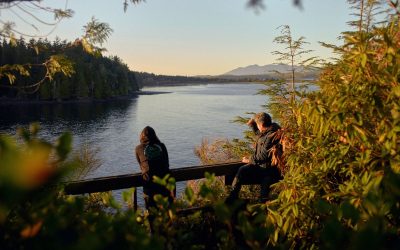We asked our readers to tell us their destination’s biggest branding challenge. (The poll has since closed.) About 70% chose “involving our tourism industry to educate and align with our brand” as a significant obstacle, ranking it either four or five out of five in difficulty.
Some of you will feel validated to find out that you aren’t the only DMO with this problem. In fact, we’ve heard this from some of our own clients too.
Why do so many destination brand managers struggle to lead and coordinate their communities? How can they improve?
To answer this, start with a fundamental question: where does a destination brand come from?
“A destination can’t rely on advertising to build its brand. Trying to impose meaning on a place is futile. Instead, a brand needs to come from within the place and its people,” says Sarah Prud’homme, Senior Strategic Consultant at Destination Think.

Sarah Prud’homme, Senior Strategic Consultant at Destination Think
This runs contrary to traditional brand marketing approaches.
Destinations are not commodities to be shaped or invented by advertising executives. They are collections of people and places that have been evolving for as long as human history. On a relational level, a destination might be the most complex product on earth. This complexity creates a distinct feel or sense of place that a destination can call its own. It isn’t a DMO’s job to build an identity; its job is to help the destination share it together.
At the 2018 Educational Seminar for Tourism Organizations (ESTO) conference in Phoenix, Arizona, our Chief Strategist Willam Bakker summed it up this way in his presentation:
Your destination brand is a choice. Its identity is not a choice. @wilhelmus explaining @DstnThink #PlaceDNA at #ESTO18.
— Michaela Saunders (@SaundersM) August 13, 2018
“Your destination brand is a choice. Its identity is not a choice.”
In other words, your destination’s identity is the foundation of its brand and brand strategy. The identity can’t be replaced overnight. Instead, core identity (Place DNA®) gradually changes with people and culture. Compared to the rapid pace of digital marketing and advertising, we’re talking about geologic timescales.
Branding a destination is a long-term endeavour.
If DMOs can’t paint an entirely new brand on an old identity, what should they do instead?
Listen, learn, and engage, says Prud’homme. “Before making decisions, there needs to be a very strong understanding of the destination brand’s strengths, weaknesses, and opportunities. DMOs make a big mistake when they don’t build meaningful collaboration into the process. You can be the one who’s setting direction or casting vision, but if you want people to buy in, you have to bring them along. And it takes time to do that well.”
Meaningful collaboration like this can avoid costly objections later. Some places have learned this the hard way.
But charting a course doesn’t mean announcing a new personality for the destination and forcing people to adopt it. A destination’s brand belongs to its people, not to the DMO. Your destination can begin to set a direction only after gathering all the research, including stakeholder input, to gain a complete picture.
“Tourism operators often say that they don’t understand how the destination brand works for them. That happens when the DMO doesn’t take the time to understand their ambitions for the brand,” says Prud’homme.
“The worst thing a DMO can do is to tell people to fall in line and follow the DMO’s vision. Or stop at surface-level engagement.”
Ongoing collaboration is vital
Building a brand is a multi-stage process. After researching destination identity and developing the brand strategy, DMOs can begin to implement changes. This isn’t time to retreat into the boardroom. Instead, keep everyone engaged in a meaningful way.
A destination needs to guide and influence its operators toward brand consistency across all communication and experiences. One easy win for brand managers is to adopt an open-source philosophy toward brand assets, says Prud’homme.
“It’s like the WestJet model. Their slogan is, ‘We’re all owners.’ So make all of your brand tools easily accessible, including images, logos, fonts, colours, and guidelines. Why hide your best brand assets? If your operators begin using your destination’s most powerful visuals, everyone wins.”
Your DMO can also influence tourism experiences. DMO-led education programs can help operators understand how their products impact online word of mouth and where their origin stories overlap with the destination brand. Each business owner can find a role to play. When a destination works in sync, it can build a cohesive, destination-wide narrative, as places like Nashville (a.k.a. Music City) have found.
Think beyond the tourism industry
Destinations also need to recognize that their stakeholders include residents and businesses in many industries.
“It’s important that locals are aligned and bought into the brand. That’s a huge blind spot for DMOs. Some only look to promote, to push messages outside the destination. But when residents buy in and believe in the brand, they will become advocates too.”
The Dutch city of Eindhoven uses its brand built on identity to engage visitors and passionate residents.
This Is Eindhoven makes this ambition clear on its website:
“The Eindhoven brand is a dynamic brand that belongs to the city council but also to the city itself. The ‘vibes’ of the brand logo are free for every person in Eindhoven to invest his or her energy in.
Do you feel the Eindhoven vibe too? Share it on social media by using #SharetheVibe and #Eindhovencity.”
By getting out of the spotlight, DMOs can allow the brightest lights of their destination to shine.
Would you donate time and energy to your DMO?
Above all, successful destination branding cannot happen without trust. An inclusive process designed for ongoing collaboration and clear results is the best way to build long-lasting brand success.
Ideally, your DMO can invite tourism stakeholders and residents to participate and contribute ideas in person. Destination Think has led collaborations with organizations like Provincie Limburg, Gold Coast Tourism, and Tourism Calgary that include a research phase with interactive workshops. Those DMOs were then able to better understand how residents see the destination and what visitors need.
Vanessa Gagnon, Brand Manager at Tourism Calgary, noted that this process gave the DMO “a robust set of data, insights into our reputation that are rooted in research, and hyper-engaged partners.”
Review: 8 tips for destination branding and healthy stakeholder relationships
- Research and work with your community to uncover your destination’s true identity, or Place DNA®.
- Build meaningful collaboration into the branding process.
- Keep people involved through the whole process, including the implementation phase.
- Use an open-source philosophy with your brand assets.
- The people own the brand; your DMO owns the brand strategy.
- Involve residents and people in other industries.
- Get your DMO out of the spotlight. Instead, let your destination’s brightest lights shine.
- Build trust with an inclusive process designed for collaboration.
One more thing. If you’ve been nodding your way through this article, you might be ready to reach out to the experienced branding team at Destination Think. Our process is designed to help you excel and optimize your DMO for the modern world. Or, send us your brand RFP. We are only a few clicks away.
More resources to help you involve your tourism industry in destination marketing and branding:
- Place brand manager roles are expanding: here’s why and what to do next
- Why place branding needs to be built from the inside
- Working in isolation is risky. Here’s why Tourism Calgary built strategy and brand with a team-wide, collaborative process.
- How destinations can increase word-of-mouth promotion by designing socialgenic experiences









0 Comments